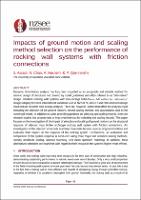| dc.description.abstract | Dynamic time-history analysis has long been regarded as an acceptable and reliable method for seismic design of structures not covered by codal guidelines and often referred to as "alternative" design. Resilient rocking wall systems with low-damage hold-downs fall within the ‘alternative’ design category for most international standards such as NZS1170, ASCE7 and NBCC20 and design must include dynamic time-history analysis. There are, however, factors that affect the analysis result including the selection of the ground motions, record scaling method, and assumptions used in the numerical model. In addition to codes providing guidance on selecting and scaling records, there are numerous research studies that propose new or improved methods for selecting and scaling records. This paper focuses on the investigation of the impact of selection and scaling of ground motions on the structural response of selected archetype rocking wall system with friction connections. The selection of records investigation looks at characterization criteria such as tectonic source, earthquake magnitude, distance and peak ground acceleration as well as more crucial criteria such as source mechanism, fault type, directivity, among others, and evaluates the impact of each criterion on the performance of the rocking system. An evaluation and comparison of the system response is conducted using three main and common scaling methods, namely amplitude scaling, spectral matching, and mean spectrum modification. The impact of the criteria on the system's higher mode effects is further investigated. This paper will provide valuable insights for those interested in adopting friction connections for low damage design. | |

